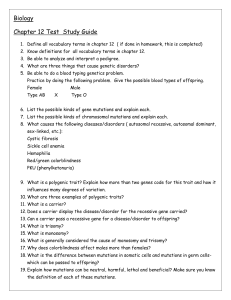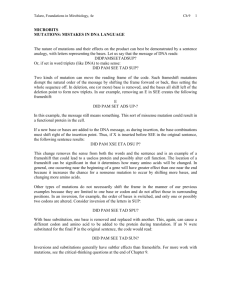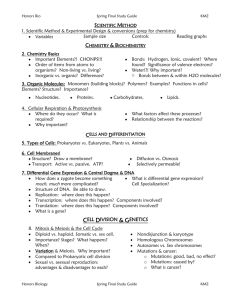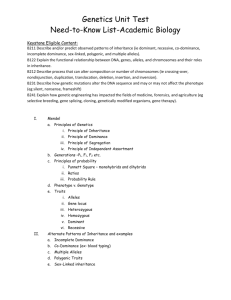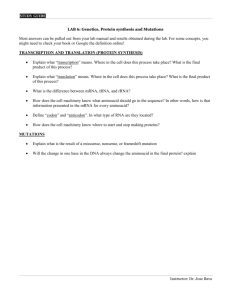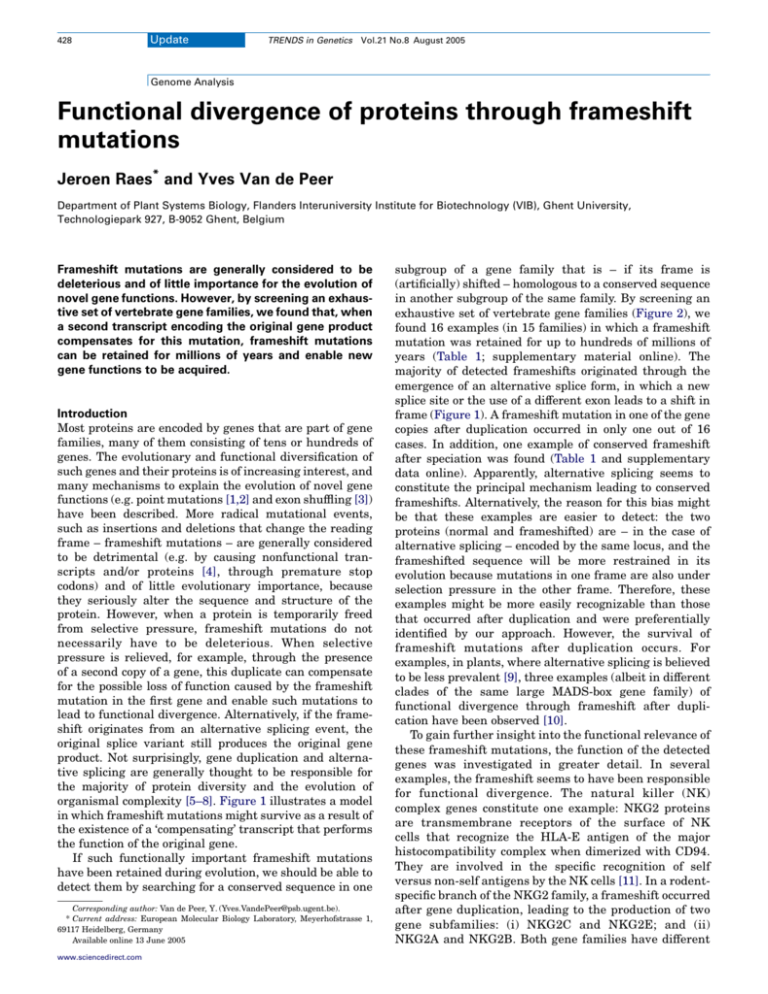
428
Update
TRENDS in Genetics Vol.21 No.8 August 2005
Genome Analysis
Functional divergence of proteins through frameshift
mutations
Jeroen Raes* and Yves Van de Peer
Department of Plant Systems Biology, Flanders Interuniversity Institute for Biotechnology (VIB), Ghent University,
Technologiepark 927, B-9052 Ghent, Belgium
Frameshift mutations are generally considered to be
deleterious and of little importance for the evolution of
novel gene functions. However, by screening an exhaustive set of vertebrate gene families, we found that, when
a second transcript encoding the original gene product
compensates for this mutation, frameshift mutations
can be retained for millions of years and enable new
gene functions to be acquired.
Introduction
Most proteins are encoded by genes that are part of gene
families, many of them consisting of tens or hundreds of
genes. The evolutionary and functional diversification of
such genes and their proteins is of increasing interest, and
many mechanisms to explain the evolution of novel gene
functions (e.g. point mutations [1,2] and exon shuffling [3])
have been described. More radical mutational events,
such as insertions and deletions that change the reading
frame – frameshift mutations – are generally considered
to be detrimental (e.g. by causing nonfunctional transcripts and/or proteins [4], through premature stop
codons) and of little evolutionary importance, because
they seriously alter the sequence and structure of the
protein. However, when a protein is temporarily freed
from selective pressure, frameshift mutations do not
necessarily have to be deleterious. When selective
pressure is relieved, for example, through the presence
of a second copy of a gene, this duplicate can compensate
for the possible loss of function caused by the frameshift
mutation in the first gene and enable such mutations to
lead to functional divergence. Alternatively, if the frameshift originates from an alternative splicing event, the
original splice variant still produces the original gene
product. Not surprisingly, gene duplication and alternative splicing are generally thought to be responsible for
the majority of protein diversity and the evolution of
organismal complexity [5–8]. Figure 1 illustrates a model
in which frameshift mutations might survive as a result of
the existence of a ‘compensating’ transcript that performs
the function of the original gene.
If such functionally important frameshift mutations
have been retained during evolution, we should be able to
detect them by searching for a conserved sequence in one
Corresponding author: Van de Peer, Y. (Yves.VandePeer@psb.ugent.be).
* Current address: European Molecular Biology Laboratory, Meyerhofstrasse 1,
69117 Heidelberg, Germany
Available online 13 June 2005
www.sciencedirect.com
subgroup of a gene family that is – if its frame is
(artificially) shifted – homologous to a conserved sequence
in another subgroup of the same family. By screening an
exhaustive set of vertebrate gene families (Figure 2), we
found 16 examples (in 15 families) in which a frameshift
mutation was retained for up to hundreds of millions of
years (Table 1; supplementary material online). The
majority of detected frameshifts originated through the
emergence of an alternative splice form, in which a new
splice site or the use of a different exon leads to a shift in
frame (Figure 1). A frameshift mutation in one of the gene
copies after duplication occurred in only one out of 16
cases. In addition, one example of conserved frameshift
after speciation was found (Table 1 and supplementary
data online). Apparently, alternative splicing seems to
constitute the principal mechanism leading to conserved
frameshifts. Alternatively, the reason for this bias might
be that these examples are easier to detect: the two
proteins (normal and frameshifted) are – in the case of
alternative splicing – encoded by the same locus, and the
frameshifted sequence will be more restrained in its
evolution because mutations in one frame are also under
selection pressure in the other frame. Therefore, these
examples might be more easily recognizable than those
that occurred after duplication and were preferentially
identified by our approach. However, the survival of
frameshift mutations after duplication occurs. For
examples, in plants, where alternative splicing is believed
to be less prevalent [9], three examples (albeit in different
clades of the same large MADS-box gene family) of
functional divergence through frameshift after duplication have been observed [10].
To gain further insight into the functional relevance of
these frameshift mutations, the function of the detected
genes was investigated in greater detail. In several
examples, the frameshift seems to have been responsible
for functional divergence. The natural killer (NK)
complex genes constitute one example: NKG2 proteins
are transmembrane receptors of the surface of NK
cells that recognize the HLA-E antigen of the major
histocompatibility complex when dimerized with CD94.
They are involved in the specific recognition of self
versus non-self antigens by the NK cells [11]. In a rodentspecific branch of the NKG2 family, a frameshift occurred
after gene duplication, leading to the production of two
gene subfamilies: (i) NKG2C and NKG2E; and (ii)
NKG2A and NKG2B. Both gene families have different
Update
TRENDS in Genetics Vol.21 No.8 August 2005
GCT TTG
A
L
Alternative splicing
causing frameshift
GCT TTG
A
G
GCT TTG AAC T
C P
GGA TGT CCA GTT AGC TAA
G
C P
G S
*
Duplication
and frameshift mutation
GGA TGT CCA GTT AGC TAA
L
429
G S
*
GCT TTG
A
L
G
L
N
W M S
S
A
L
G S
*
AAA T
K
TGG ATG TCC AGT TAG
*
A
GCT TTG
C P
GG ATG TCC AGT TAG
GCT TTG
A
GGA TGT CCA GTT AGC TAA
L
W M S
S *
GG ATG TCC AGT TAG
W M S
S
*
Ancestral function
New function
TRENDS in Genetics
Figure 1. Evolving novel protein functions by frameshift mutations. After gene duplication, a frameshift mutation can escape ‘the relentless pressure of natural selection’
through the existence of a second copy [4]. In alternative splicing, an additional transcript containing a frameshift can arise, for example, through the use of a new splice site
changing the phase of the intron, which alters the reading frame for the remainder of the transcript. However, alternative splicing can lead to the insertion of an additional,
frameshifting exon.
functions: NKG2C-containing complexes activate NK
cells on binding of the antigen, whereas NKG2-A inhibits
them. The functional difference can be clearly linked to
the frameshift mutation because the cytoplasmic
N-terminal tail of the NKG2A receptor contains an
immunoreceptor tyrosine-based inhibitory motif (ITIM)
that is crucial for the transmission of the inhibitory
signal. This motif is altered through the frameshift in the
NKG2C receptor, producing the activating functionality
of this protein [12].
Similarly, the C-terminal frameshift in the paired box
gene 8 (PAX8) family of transcription factors leads to
isoforms with reduced in vitro transactivation efficiency,
which, in thyroid tissues, results from the loss of
interaction with the synergistically acting thyroid transcription factor 1 (TTF-1) [13,14].
HOVERGEN curated database
of vertebrate gene families
Select genes with frameshift
For each gene family with more than
five numbers:
compare a six-frame translated
nucleotide sequence of each
family member with all protein
sequences (blastx)
Select families where frameshifted
sequence is conserved:
- among more than two family members
- among more than two species
Discard in-frame
hits (+1)
Extract
out-of-frame hits
with E-value < 0.01
Manual validation
TRENDS in Genetics
Figure 2. A flowchart of the approach used to screen vertebrate gene families. Gene families with more than five members were extracted from the HOVERGEN (release 43)
curated gene family database (http://pbil.univ-lyon1.fr/databases/hovergen.html) [26]. For each gene family, the coding (nucleotide) sequence of each family member was
translated in all six reading frames and compared with the protein sequence of all other members using BLASTX at default-parameter settings [27]. From all significant
within-family, out-of-frame hits, the genes that contained the frameshift mutations were inferred. For this set of genes, the frameshifted regions were extracted and grouped
based on their sequence similarity. Clusters of similar sequences were retained if they contained at least two family members from different species, to exclude the possibility
of sequencing errors. Gene families yielding retained clusters (i.e. gene families containing within-family frameshifted sequences conserved in multiple species) were finally
subjected to manual verification. Furthermore, expression of the transcripts was confirmed by the presence of a full-length cDNA in the databases and/or from literature
(Table 1). Further details of the methodology can be found in the supplementary data online.
www.sciencedirect.com
Update
430
TRENDS in Genetics Vol.21 No.8 August 2005
Table 1. Gene families containing conserved frameshift mutationsa
Hovergen
Function
familyb
Transcription factors
HBG000122
Pbx homeodomain
protein
HBG000419
T-cell transcription
factor
HBG006561
Nuclear factor 1
HBG009115
HBG017385
HBG020791
Mechanism
Position
Downstream effect
Predicted NMD
candidate?
Expressed?
Divergence
Alternative
splicing
Alternative
splicing
Alternative
splicing
Alternative
splicing
Alternative
splicing
Alternative
splicing
C-terminal
Premature stop
No
Yes
C-terminal
Premature stop
No
Yes
C-terminal
Premature stop
No
Yes
C-terminal
Premature stop
No
Yes
C-terminal
Longer protein
N.A.
Unknown
C-terminal
Premature stop
Yes
Yes
Fish–human
(450 Mya)
Frog–human
(350 Mya)
Frog–human
(350 Mya)
Dog–human
(95 Mya)
Rodents–human
(80 Mya)
Rodents–human
(80 Mya)
Alternative
splicing
Alternative
splicing
Alternative
splicing
C-terminal
Premature stop
No
Yes
C-terminal
Premature stop
No
Yes
C-terminal
Premature stop
No
Yes
Duplication
N-terminal
Corrected
N.A.
Yes
Speciation
C-terminal
Premature stop
No
Yes
Granuphilin
Alternative
splicing
C-terminal
Premature stop
No
Yes
G-protein-coupled
receptor kinase
p58 protein kinase
Alternative
splicing
Alternative
splicing
Alternative
splicing
Alternative
splicing
C-terminal
Premature stop
No
Yes
N-terminal
Corrected
N.A.
Yes
C-terminal
Premature stop
No
Yes
C-terminal
Premature stop
No
Yes
Paired box (Pax)
transcription factor
Odd-skipped related
transcription factor
RBCK
Transmembrane proteins
HBG001463
Equilbrative nucleoside transporter
HBG004374
Rhesus blood group
protein
HBG007562
CIRL or latrophilin
G-protein-coupled
receptor
HBG012748
NKG2 natural killercell receptor
HBG016641
Other
HBG004532
HBG014652
HBG014779
HBG015298
a
Testis-specific
protein Y
Epididymis-specific
EP2 protein
Rodents–human
(80 Mya)
Within primates
(10 Mya)
Cow–human
(95 Mya)
Within rodents
(40 Mya)
Within primates
(10 Mya)
Within rodents
(40 Mya)
Rodents–human
(80 Mya)
Within rodents
(40 Mya)
Within monkeys
(20 Mya)
Within primates
(10 Mya)
Abbreviations: CIRL, Ca2C-independent receptor for a-latrotoxin; Mya, million years ago; N.A., not applicable.
For more details, see http://pbil.univ-lyon1.fr/databases/hovergen.html [26].
b
By compiling the functions of all detected mutations,
we noticed that approximately two-thirds of the gene
families with conserved frameshifts consisted of either
transcription factors or transmembrane proteins
(Table 1). One possible explanation for the apparent
preferential retention of frameshift mutations in these
classes lies in the structural organization of functional
domains in these proteins. In 14 of the 16 cases, frameshift
mutations are positioned in the C-terminus. This is not
unexpected, because frameshift mutations are generally
less harmful if they are near the end of the sequence.
However, for both transcription factors and transmembrane proteins, mutations in the C-terminus
especially influence those regions that are sensitive to
functional diversification. In transcription factors,
C-termini are regularly involved in transactivation,
repression or in protein–protein interactions [15],
whereas in transmembrane proteins, they usually constitute the cytoplasmic or extracellular regions of the
protein and have, for example, ligand-binding- or signalpropagation functions.
In addition to frameshifts that are compensated by a
second transcript (Figure 1), it should be noted that we
have also found one example of a frameshift mutation that
occurs after speciation. A recent frameshift within the
www.sciencedirect.com
NK-cell receptors that is primate-specific could be
important for recent adaptations of the primate (and
thus human) immune system. Therefore, in these cases,
the frameshift has been retained without the existence of
a compensating transcript, although it remains possible
that the original function is exerted by a more distant
member of the family or through an alternative route in
the pathway [16].
One might argue that the frameshift mutations
described here do not cause the acquisition of a new
function, but simply infer a partial loss of function in one
of the transcripts by ‘erasing’ a downstream protein
domain [17]. For example, if a C-terminally truncated
transcription factor contained a functioning DNA-binding
domain, but lost its transactivation domain, it could act as
a repressor solely by using the former domain and
competing with the latter, functional copy [18]. The
frameshifted sequence would then not be of crucial
functional importance, contrary to our hypothesis. However, the alternative frame is still conserved during
evolution, indicating that it is under considerable purifying selection. The same locus is also used in the original
frame, and any synonymous (e.g. third codon) mutation in
the original frame will, in most cases, result in a
nonsynonymous mutation in the shifted frame. Therefore,
Update
TRENDS in Genetics Vol.21 No.8 August 2005
given that synonymous mutations in the original frame
are under low selectional pressure, the conservation of the
frameshifted sequence, despite the ‘easy’ accumulation of
mutations in the original frame, shows that this sequence
is selected for and thus of functional importance. We would
argue that the conserved frameshifted sequences
described here might prove useful in understanding the
function of these genes.
Because 13 of the 16 examples reported here result in
premature stop codons, one might hypothesize that they
are probable targets of nonsense-mediated decay (NMD), a
process that limits the synthesis of abnormal proteins by
degrading truncated transcripts [19]. However, based on
the generally accepted ‘50 nucleotide rule’ (i.e. transcripts
with premature stop codons O50 nucleotides upstream of
the final exon are degraded) [20,21], only one case – within
the RBCK family – is predicted to be a target of
NMD (Table 1). RBCK2 is expressed [22], so it seems
that even this probable NMD-target escapes degradation.
Indeed, NMD was shown to display differences in
mRNA-degradation efficiency among tissues and even
among individuals; it does not completely breakdown all
premature stop-codon-containing transcripts, leading to
truncated, but functionally important, proteins [19,23].
Therefore, it seems that NMD is an additional factor in the
evolutionary conservation of frameshift mutations: if the
resulting transcript is not subject to NMD or can somehow
escape it, then the frameshifted sequence can persist and
change its function.
Concluding remarks
We propose that frameshift mutations can cause
functional divergence of proteins and that, at least in
vertebrates, this is usually linked to the presence of NMD
avoiding alternatively spliced transcripts. However,
because conserved alternatively spliced exons are rarely
frame-disturbing [24,25], the conservation of the downstream frameshifted sequence and its subsequent use for
neofunctionalization is even less obvious. As Susumu
Ohno put it: ‘Starting with a frame-shift mutation, a
duplicate might acquire a new function, which is totally
different from that assigned to the original gene.
Admittedly, this is a one in a million chance, but in
evolution, events with the odds of one in one million
occurred time and time again.’ [4] The examples described
in this article, mostly transcription factors and transmembrane proteins, have beaten these odds.
Acknowledgements
We thank Cedric Simillion for his help in algorithmic issues, Stephane
Rombauts, Evi Michels and Michiel Vandenbussche for stimulating
discussions, and Martine De Cock for help in preparing the article.
Furthermore, we thank four anonymous reviewers for their constructive
remarks. J.R. is a postdoctoral fellow of the Vlaams Instituut voor de
Bevordering van het Wetenschappelijk-Technologisch Onderzoek in de
Industrie.
Supplementary data
Supplementary data associated with this article can be
found at doi:10.1016/j.tig.2005.05.013
www.sciencedirect.com
431
References
1 Winkler, K. et al. (2000) Changing the antigen binding specificity by
single point mutations of an anti-p24 (HIV-1) antibody. J. Immunol.
165, 4505–4514
2 Zhang, J. et al. (2002) Adaptive evolution of a duplicated pancreatic
ribonuclease gene in a leaf-eating monkey. Nat. Genet. 30, 411–415
3 Long, M. et al. (2003) The origin of new genes: glimpses from the young
and old. Nat. Rev. Genet. 4, 865–875
4 Ohno, S. (1970) Evolution by Gene Duplication, Springer-Verlag
5 Van de Peer, Y. (2004) Computational approaches to unveiling ancient
genome duplications. Nat. Rev. Genet. 5, 752–763
6 International Human Genome Consortium. (2001) Initial sequencing
and analysis of the human genome. Nature 409, 860–921
7 Taylor, J. and Raes, J. (2004) Duplication and divergence: the
evolution of new genes and old ideas. Annu. Rev. Genet. 38, 615–643
8 Maniatis, T. and Tasic, B. (2002) Alternative pre-mRNA splicing and
proteome expansion in metazoans. Nature 418, 236–243
9 Brett, D. et al. (2002) Alternative splicing and genome complexity. Nat.
Genet. 30, 29–30
10 Vandenbussche, M. et al. (2003) Structural diversification and neofunctionalization during floral MADS-box gene evolution by
C-terminal frameshift mutations. Nucleic Acids Res. 31, 4401–4409
11 Vance, R.E. et al. (1998) Mouse CD94/NKG2A is a natural killer cell
receptor for the nonclassical major histocompatibility complex (MHC)
class I molecule Qa-1(b). J. Exp. Med. 188, 1841–1848
12 Lohwasser, S. et al. (1999) Cloning of murine NKG2A, B and C: second
family of C-type lectin receptors on murine NK cells. Eur. J. Immunol.
29, 755–761
13 Di Palma, T. et al. (2003) The paired domain-containing factor Pax8
and the homeodomain-containing factor TTF-1 directly interact and
synergistically activate transcription. J. Biol. Chem. 278, 3395–3402
14 Poleev, A. et al. (1995) Distinct functional properties of three human
paired-box-protein, PAX8, isoforms generated by alternative splicing
in thyroid, kidney and Wilms’ tumors. Eur. J. Biochem. 228, 899–911
15 Latchman, D.S. (1998) Eukaryotic transcription factors, Academic
Press
16 Wagner, A. (2000) Robustness against mutations in genetic networks
of yeast. Nat. Genet. 24, 355–361
17 Liu, S. and Altman, R.B. (2003) Large scale study of protein domain
distribution in the context of alternative splicing. Nucleic Acids Res.
31, 4828–4835
18 Foulkes, N.S. and Sassone-Corsi, P. (1992) More is better: activators
and repressors from the same gene. Cell 68, 411–414
19 Holbrook, J.A. et al. (2004) Nonsense-mediated decay approaches the
clinic. Nat. Genet. 36, 801–808
20 Hillman, R.T. et al. (2004) An unappreciated role for RNA
surveillance. Genome Biol. 5, R8
21 Nagy, E. and Maquat, L.E. (1998) A rule for termination-codon
position within intron-containing genes: when nonsense affects RNA
abundance. Trends Biochem. Sci. 23, 198–199
22 Tokunaga, C. et al. (1998) Molecular cloning and characterization of
RBCK2, a splicing variant of a RBCC family protein, RBCK1. FEBS
Lett. 435, 11–15
23 Neu-Yilik, G. et al. (2004) Nonsense-mediated mRNA decay: from
vacuum cleaner to Swiss army knife. Genome Biol. 5, 218
24 Sorek, R. et al. (2004) How prevalent is functional alternative splicing
in the human genome? Trends Genet. 20, 68–71
25 Resch, A. et al. (2004) Evidence for a subpopulation of conserved
alternative splicing events under selection pressure for protein
reading frame preservation. Nucleic Acids Res. 32, 1261–1269
26 Duret, L. et al. (1994) HOVERGEN: a database of homologous
vertebrate genes. Nucleic Acids Res. 22, 2360–2365
27 Altschul, S.F. et al. (1997) Gapped BLAST and PSI-BLAST: a new
generation of protein database search programs. Nucleic Acids Res.
25, 3389–3402
0168-9525/$ - see front matter Q 2005 Elsevier Ltd. All rights reserved.
doi:10.1016/j.tig.2005.05.013

